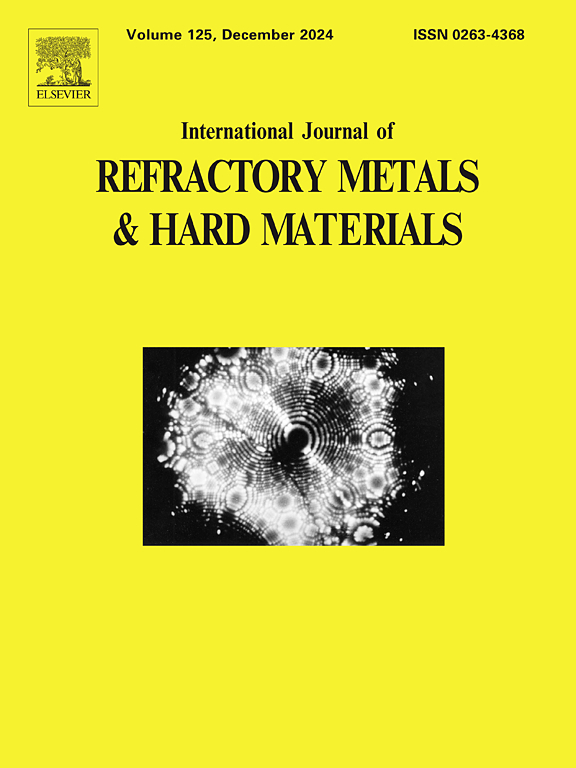Low-activation joining methods for cWC and RSBs on steel for nuclear applications
IF 4.2
2区 材料科学
Q2 MATERIALS SCIENCE, MULTIDISCIPLINARY
International Journal of Refractory Metals & Hard Materials
Pub Date : 2025-02-12
DOI:10.1016/j.ijrmhm.2025.107093
引用次数: 0
Abstract
Cemented tungsten carbides (cWCs) and reactive sintered borides (RSB) are novel radiation-dense materials that are recent candidates as reactor shielding for compact spherical tokamaks (cST). This work investigates the use of pressure-less sinter-fusing methods for joining dissimilar materials for use in activating environments. Pressure-less sinter-fusing shows promise as a relatively non-invasive joining method for dissimilar materials, and it can be performed in an inert atmosphere or under vacuum. Sinter-fusing as a method for joining low-activation cWC and RSB materials to mild steels was investigated using various braze alloy mixtures as a paste and metal foils. A selection of low-activation braze alloys was investigated to join cWC and RSB to steel using sinter-fusing at 1300 °C in Ar for 2 h. Low-activating braze alloys were based on Cu and Fe as the major components with additions including Cr, Zr, Ti, C, B and Si as minor components. SEM-EDX was used to assess the quality of bonding and diffusion of the braze compounds post-sintering. The Vickers hardness mechanical test was carried out for the base materials and the joint interface, and the fracture toughness values were calculated from the hardness data. Results show that both brazing paste and foils have achieved well joints with no cracks and pores, but Cu foil-based joints shown superior to that of brazing paste concerning their mechanical properties.
核用钢上cWC和RSBs的低活化连接方法
硬质合金(cWCs)和反应烧结硼化物(RSB)是一种新型的辐射密集材料,是紧凑球形托卡马克(cST)反应堆屏蔽的候选材料。这项工作研究了使用无压力烧结熔合方法来连接不同的材料,用于激活环境。无压烧结熔合作为一种相对无创的连接不同材料的方法,它可以在惰性气氛或真空下进行。采用不同的钎焊合金混合物作为膏体和金属箔,研究了烧结熔焊将低活化cWC和RSB材料连接到低碳钢上的方法。以Cu和Fe为主要成分,添加Cr、Zr、Ti、C、B和Si为次要成分的低活性钎焊合金为研究对象,在1300℃氩气中烧结熔炼2h,选择了低活性钎焊合金将cWC和RSB连接到钢中。利用SEM-EDX对烧结后钎焊化合物的结合和扩散质量进行了评价。对基材和接头界面进行了维氏硬度力学试验,并根据硬度数据计算了断裂韧性值。结果表明:钎焊膏和箔均能实现无裂纹、无气孔的良好连接,但铜箔的连接力学性能优于钎焊膏。
本文章由计算机程序翻译,如有差异,请以英文原文为准。
求助全文
约1分钟内获得全文
求助全文
来源期刊
CiteScore
7.00
自引率
13.90%
发文量
236
审稿时长
35 days
期刊介绍:
The International Journal of Refractory Metals and Hard Materials (IJRMHM) publishes original research articles concerned with all aspects of refractory metals and hard materials. Refractory metals are defined as metals with melting points higher than 1800 °C. These are tungsten, molybdenum, chromium, tantalum, niobium, hafnium, and rhenium, as well as many compounds and alloys based thereupon. Hard materials that are included in the scope of this journal are defined as materials with hardness values higher than 1000 kg/mm2, primarily intended for applications as manufacturing tools or wear resistant components in mechanical systems. Thus they encompass carbides, nitrides and borides of metals, and related compounds. A special focus of this journal is put on the family of hardmetals, which is also known as cemented tungsten carbide, and cermets which are based on titanium carbide and carbonitrides with or without a metal binder. Ceramics and superhard materials including diamond and cubic boron nitride may also be accepted provided the subject material is presented as hard materials as defined above.

 求助内容:
求助内容: 应助结果提醒方式:
应助结果提醒方式:


